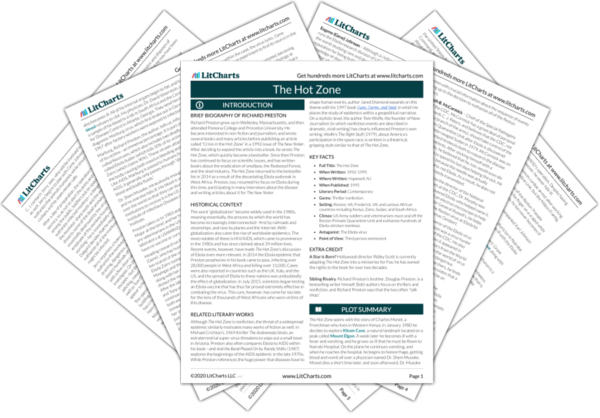Summary
Analysis
On November 27th at 7 AM, Tom Geisbert returns to the Institute to check on the monkey cells, which have formed a small “dot the size of a toast crumb” in the centrifuge. Geisbert uses a diamond knife—“the sharpest cutting edge of any tool on earth”—which is even able to split one particle of a virus cleanly in half. He attaches the diamond knife to a cutting machine, and watches through the microscope as infinitesimally small slices fall and attach themselves to a droplet of water. He next uses a human eyelash to stir the water droplet in order to separate the slices from each other. Using a tiny copper grid as a net, he scoops up a slice of cell and puts it into small box. He takes the sample to the room that holds the electron microscope, and attaches the grid to the microscope’s sample holder, so it is “centered in the beam of electrons.” Turning off all the lights in the room, Geisbert turns on the microscope and goes to a viewing screen, wondering at the immense complexity of the cell before him.
This passage’s detailed and involved description of Geisbert’s process helps the reader to understand the incredible delicacy and concentration that it takes to perform a job like this, and emphasizes the power of human curiosity and innovation. At the same time, this complicated procedure is dwarfed by the complexity of the cell, which is a product of natural (rather than human) design. Thus Preston is simultaneously illustrating the power that humans have over the natural world, and emphasizing how small that power is compared to the force of nature itself.
Themes
As the cell comes into focus, Geisbert knows that something is wrong—the cell has been utterly destroyed, and is filled with viruses that look like buckets of rope. Instantly knowing that he is looking at a filovirus, his first thought is “Marburg.” Panicking, he recalls how similar this sample looks to Peter Cardinal’s, and realizes that he and Peter Jahrling may have smelled a hot Level 4 agent.
This passage, in which Geisbert at last realizes that they have been dealing with a filovirus all along, is a climactic one within the section. Geisbert’s horror at his discovery is compounded by his realization that both he and Jahrling have been exposed to it, however briefly.
Themes
Geisbert takes pictures of the scene before him, and goes to the darkroom to develop them. As he does so, he counts backwards, realizing it’s been ten days since he inhaled the virus, meaning that he has eight more days in which to fall ill. Feeling paranoid, he wonders whether he has a headache or feels feverish, and tries to think about whether he was in fact exposed. Then he backtracks, speculating that perhaps his inexperience has made him misidentify the virus. Yet looking at the images he’s developed, he sees virus particles shaped like snakes, as if they were “the hair of Medusa.” The life form is beautiful, Geisbert thinks, even as he realizes that he may be its prey. He is also awed by what the virus has done to the cell, which Preston describes as “a chocolate-chip cookie that was mostly chocolate chips”—the “chips” in question being viral particles called inclusion bodies.
Geisbert’s sense of terror, also contains a kind of hypnotized fascination. Just as Karl Johnson referred to Ebola as a “cobra,” so too does Geisbert see great beauty and natural elegance within the structure that he views with his microscope. Preston also uses the predator/prey analogy once again, comparing Ebola to a hungry and ferocious animal in order to vividly evoke the very real danger that it poses to all humans who come across it.
Themes
Preston explains the term “inclusion bodies,” which are masses of viral particles that form brick-shaped structures, pushing outwards until they hit the cell wall, at which point they disintegrate into threads and move out into the bloodstream. The bricks make the cell bulge and eventually burst. Thomas Geisbert realizes that the granules he saw under the light microscope were actually inclusion bodies, and that the sick cells he saw were bursting full of their viral load.
This passage emphasizes, on a microscopic level, just how powerful Ebola virus is. A virus’s only job is to multiply, and Ebola has done that so effectively that the infected cells are literally bursting with viruses—a scientific yet vivid description of the incredible virulence that Ebola possesses.
Themes
Get the entire The Hot Zone LitChart as a printable PDF.













